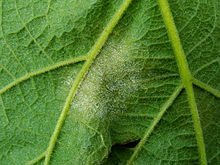Plasmopara viticola
| Plasmopara viticola | |
|---|---|
 |
|
| Scientific classification | |
| (unranked): | SAR |
| Superphylum: | Heterokonta |
| Class: | Oomycota |
| Order: | Peronosporales |
| Family: | Peronosporaceae |
| Genus: | Plasmopara |
| Species: | P. viticola |
| Binomial name | |
|
Plasmopara viticola (Berk. & M.A. Curtis) Berl. & De Toni, (1888) |
|
| Synonyms | |
|
|
Plasmopara viticola, the causal agent of grapevine downy mildew, is a heterothallic oomycete that overwinters as oospores in leaf litter and soil. In the spring, oospores germinate to produce macrosporangia, which under wet condition release zoospores. Zoospores are splashed by rain into the canopy, where they swim to and infect through stomata. After 7–10 days, yellow lesions appear on foliage. During favorable weather, the lesions sporulate and new secondary infections occur.
Plasmopara viticola, also known as grape downy mildew is considered to be the most devastating disease of grapevines in climates with relatively warm and humid summers. It was first observed in 1834 by Schweinitz on Vitis aestivalis in the southeastern of the United States. Shortly after this first observation, the pathogen was introduced to European countries where it played a devastating role in the yield and production of their grapes, and consequently their wine. France was among the first of the European countries to gain experience in dealing with the pathogen. Within just a few years of the pathogen's introduction the French attempted to graft American root stock to their own vines in order to produce a more resistant strain of grape. Depending on the year, production of grapes in France has been estimated to have been reduced by as much as 50%. Because of numbers and results like these, downy mildew has been considered the most devastating disease of a filamentous pathogen to affect European vineyards.
Symptoms cover a fairly large range depending mostly on the host. Common symptoms include necrosis of the stem or shoot, discoloration including brown spotting (lesions) and yellowish-green tips of the leaves. Grapes may exhibit sporangia and sporangiophores, appearing as white to gray coat on the outer surface.
Downy mildew has a specific set of environmental conditions to reproduce and infect. A warm, moist, and humid environment is required. Studies in Sicily have shown optimum time for oospore germination is between the end of February and the middle of March. With this understanding, if fungicides are used just before optimum conditions occur, they have proven to be an effective control method of the pathogen. Other control methods include proper watering, and a good location where the plant can receive continual sunlight.
The hosts of the Plasmopara viticola pathogen are the European Vitis vinifera and the American vitis varieties. The European cultivar is most susceptible to the pathogen, as it lacks evolutionary resistance that the American varieties have. This is because the pathogen originated in the Americas and was later transmitted into Europe. Regardless of cultivar, once this oomycete lands on a susceptible host, the disease cycle begins. The first symptom to occur includes irregular, yellow spots on the surface of the leaves. Over time, if one follows these spots through a cross-section of the leaf to the bottom, bunches of sporangia will be found. Sporangia will form the “white downy” appearance of the leaves, giving the pathogen it’s common name. As the disease progresses, the yellow surface spots turn brown due to necrosis, death, of the plant tissue. Furthermore, the underside of the leaves progress from a white color to grey. The ultimate result is premature defoliation, when the infected leaves detach from the stem. Moving from symptoms of the leaves to that of the grapes, when the pathogen is present, the growing fruit become covered with the sporangiophores. This results possible thickening of the fruit “skin” or distortion of shape. A color change from purple to a reddish brown can be noted as well as a mosaic pattern when the grapes are infected.
...
Wikipedia
